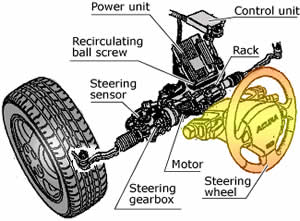Difference between Power Steering and Hydraulic Steering
Key Difference: Power steering is a system that helps in steering the wheels by using some source of power. Hydraulic steering is a kind of power steering in which a hydraulic system using pressurized hydraulic fluid assists in steering the wheels of vehicles.
Steering refers to guiding the wheels towards the intended direction. You must be familiar with the steering systems of cars. The driver uses the steering to control the course taken by wheels. Power steering is a system that helps in steering the wheels using some source of power. Manual steering is totally different type of steering in which manual force is used for steering. However, today most of the cars have power steering systems.
When we talk about power steering, than we are either referring to hydraulic power steering or electric power steering. Thus, we can say that electronic power steering and hydraulic power steering are types of power steering and thus both possess all the features of a power steering system. There are two basic steering mechanisms:-
 1. Rack and pinion steering- in this system a pinion gear is attached to the steering shaft which means that as the steering wheel is turned it turns the pinion gear(circular) and then moves the rack (linear). It is basically using the rotational motion of steering wheels and then converting this rotational motion into the linear motion. This linear motion is required to turn the wheels.
1. Rack and pinion steering- in this system a pinion gear is attached to the steering shaft which means that as the steering wheel is turned it turns the pinion gear(circular) and then moves the rack (linear). It is basically using the rotational motion of steering wheels and then converting this rotational motion into the linear motion. This linear motion is required to turn the wheels.
2. Recalculating ball steering- in this system, a box is fastened over a worm drive that contains many ball bearings. These ball bearings loop around the worm drive and these balls moves out into a recirculation channel and again gets back into the worm drive. When the steering wheel is turned, the worm drive turns and forces the balls to press against the channel inside the nut. Now this forces the nut to move along the worm drive
Let us now understand the basic concepts of power steering. Power steering uses hydraulics or fluid pressure in order to help the steering systems. Power steering is preferred when quick turns need to be taken.
There are three main power steering components- power steering pump, power steering fluid reservoir, steering gear box. Power steering can be of three types:-
- Hydraulic power steering
- Electric power hydraulic steering (EPHS)
- fully electric power steering(EPS)
Hydraulic power steering mainly uses a hydraulic fluid, and the pressure that is generated through this hydraulic fluid helps the driver in steering the wheels. Let us explain in detail- As the term suggests, hydraulic steering makes use of hydraulic systems in order to steer the vehicles. The hydraulic pressure is generated by using a gerotor or rotary vane pump that I s driven by the engine. A force is then applied to the steering gear. This force that is applied by the cylinder steers the wheels. The working liquid is also known by the name ‘hydraulic fluid’ or oil. It serves the purpose of medium by which the pressure is transmitted. However, the pump and system components of these hydraulic power-assisted steering must be designed to ensure three important things:-
detail- As the term suggests, hydraulic steering makes use of hydraulic systems in order to steer the vehicles. The hydraulic pressure is generated by using a gerotor or rotary vane pump that I s driven by the engine. A force is then applied to the steering gear. This force that is applied by the cylinder steers the wheels. The working liquid is also known by the name ‘hydraulic fluid’ or oil. It serves the purpose of medium by which the pressure is transmitted. However, the pump and system components of these hydraulic power-assisted steering must be designed to ensure three important things:-
- The temperature of the hydraulic fluid remains at optimum temperature (less than 100 degrees centigrade
- Not much noise should be generated.
- Oil should not foam.
However, some modern systems also include an electronic control value and are known as electric power hydraulic steering. These systems are known as the EPHS. In EPHS the customary drive belts and pulleys that drive a power steering pump are replaced by a brushless motor. It is driven by an electric motor and thus also reduces the amount of power that needs to be taken from the engine otherwise. The third category is electric power steering. In this kind of system, an electric motor replaces the hydraulic pump and a fully electric power steering system is established. The electric motor is either attached to the steering rack or to the steering column. The very important component is the electronic control unit that controls the steering dynamics.
Most of the steering systems that are used today are of power steering type. Thus, we can say that hydraulic steering is also a type of power steering. Thus, it includes all the characteristics of a power steering, it just differ in its energy source. The energy source of hydraulic power assisted steering system mainly consists of a vane pump with an integral oil flow connector and an oil reservoir.
Image Courtesy: allegromicro.com, splashmaritime.com.au









Add new comment